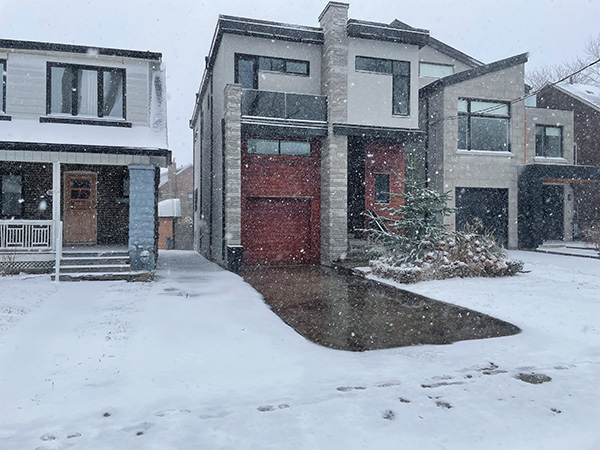
Weather or Not?
March 15, 2023 | By Curtis Bennett
Connecting a snow melt system to the internet can save time and money.
I have never claimed to be a great parent. Ok, that’s not true, I actually make that claim all the time, and I have always said that hard work is a valuable trait—something I try to instil into my kids. I have also said that I had children so I wouldn’t have to work outside anymore, and shovel snow.
This all leads me to the topic of the day: snowmelt controls.
I want to take things in a slightly different direction this time.
For those of us in the hydronics business, we have all heard the infamous stories about snowmelt systems costing homeowners $2,000 per month to operate over the winter. Why not just pay some kids to shovel for $100 per month? Well, I am not sure that’s the answer, but I do think there is a better solution.

Connected controls for snow melt are not new, but controls gleaning information from websites to drive control algorithms is fairly new. And when it comes to snow melt, what information is most useful? Well, it’s weather forecasting.
I’m going to go out on a limb and say that weather forecasting on snowmelt controls is the largest control advance in snow melting in a long time — the most significant advance since optical sensing technology.
It’s the idling of snowmelt systems that use the most energy. If a snowmelt control is set to idle, it will remain in this mode for 90% of the time.
Let me back up slightly, there are three states in a snowmelt control: off, idle and melt.
If I was going to make a snowmelt control as basic as possible, it’s a two-stage setpoint control. The first setpoint for the slab target (idle) is used when there is no snow present on the sensor. We idle the slab to react quicker when we do finally detect snow.
The melt demand happens when snow hits the sensor. At this point we change the slab target from idle up to a target that will melt the snow on the slab.
Usually, these targets are between 3C to 10C for melt with the idle target between -10C to -2C.
Now that being said, the control spends most time in idle, so it makes the most sense if we try to keep idling time to a minimum.
There are really only two ways to do this. The first is the end user is responsible for turning the snowmelt control from off and into idle. This can be with a manual demand at the control, or now with a smartphone app.
Using an app does help, but the end user still needs to know when the snow is coming. Wouldn’t it be nice if the control could know that?
Well … they can. Weather data is becoming very sophisticated, not only are there accredited weather stations, but there are thousands of data points they can gather from in any given area, even home-based weather stations. This allows for very accurate forecasting.
But what if the forecast is wrong? The amount of potential savings far surpasses the amount of false starts.
If you can set the target percentage of precipitation (POP), the end user can mitigate false starts by keeping this number higher. As well as the POP, the user can also set how far out they would like to look into the forecast.
This is truly where the value of forecasting comes in. By setting the POP to 70% and for a forecast two days ahead, if the forecast coming to the control meets these criteria, the system will come out of off mode and into idle.
On the flip side, if the forecast falls below the set point values then the control will go back to off mode.
As we all know, forecasts can change, so this is a far better way to control the idle stat than manual mode, or even worse idling all the time.
Let’s put this into a perspective. In Calgary, we fall below 0C at around mid-October, but for this example, let’s say November 1.
We stay cold until about March 1. Yes these are round numbers, but work with me here. So, let’s call that four months, or 120 days more or less.
If your control is set to idle all the time, you are constantly injecting heat into that slab. During this 120-day period we might get 10 snowfalls, at least good ones, and maybe 10 smaller ones. We will call this 20 snowfalls in total.
I will also conjecture that those snowfalls last one day. So, we have a season of 120 days where 20 of them we have to get rid of snow.
Please , don’t lambaste me here with not taking into consideration how long the slab takes to heat up, I get that, we don’t want to crack a slab so we need to control DeltaT so it takes time to heat up the slab.
So, 20 snow days out of 120, that’s 17% of the time in melting mode, and the other 83% is spent idling and the energy being put into the slab is wasted.
Even small snowmelt controls take a lot of energy, but for this quick calculation I’ll use 250,000 Btu/h. If we are injecting 250,000 Btu/h into the slab even for only six hours per day, while idling that’s 1,500,000 Btu’s per day. That’s around 1.6Gj, which right now is about $3.50. That’s $5.60 per day for 100 extra days. That’s $560 dollars.
So how can forecasting save money?
We know we won’t save all $560. We want to set up the control so that we go into idle one day before the snow comes. Since we know there will be 20 snow days, we will take off 20 days’ worth of idling money because the forecast will turn the control to idle one day before the forecasted snowfall. That $5.60 per day for 20 extra days. That’s $560 minus $112 = total “potential” savings of $448. That’s a significant saving potential per snow melting season.
For those who don’t idle their slab, well, forecasting will save you time. And at the end of the day, energy will be saved.
On a control where every single Btu evaporates into thin air, literally, I think that’s a good thing.
Our industry does not always see eye to eye, but this is one of those things where we all know that if we can do better, we should.<>

 Curtis Bennett, C.E.T, is the product development manager with HBX Control Systems in Calgary. He formed HBX Control Systems with Tom Hermann in 2002. Its systems are designed, engineered and manufactured in Canada to accommodate hydronic heating and cooling needs in residential, commercial and industrial design applications.
Curtis Bennett, C.E.T, is the product development manager with HBX Control Systems in Calgary. He formed HBX Control Systems with Tom Hermann in 2002. Its systems are designed, engineered and manufactured in Canada to accommodate hydronic heating and cooling needs in residential, commercial and industrial design applications.


